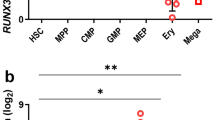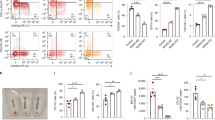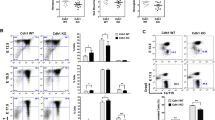Abstract
Telomerase catalytic subunit (hTERT) exerts important cellular functions including telomere homeostasis, genetic stability, cell survival and perhaps differentiation. However, the nature of external or internal signals, which regulate hTERT expression in tissues, remains poorly understood. Thus, whereas it has been described that hTERT gene is regulated along the differentiation of primitive myeloid progenitors, the effect of specific cytokines on telomerase expression in each myeloid lineage is currently unknown. Based on these considerations, we have investigated hTERT expression in erythroid cells treated with erythropoietin (EPO) and transforming growth factor β (TGFβ), as putative positive and negative regulators, respectively. We describe here that EPO activates hTERT gene transcription in in vitro-expanded primary erythroid precursors as well as in UT7 erythroleukemia cells. In UT7 cells, this study shows also that EPO acts through a JAK2/STAT5/c-myc axis. In contrast, TGFβ blocks EPO signaling downstream of c-myc induction through a Smad3-dependent mechanism. Finally, hTERT appears to be efficiently regulated by EPO and TGFβ in an opposite way in erythropoietic cells, arguing for a role of telomerase in red blood cell production.
This is a preview of subscription content, access via your institution
Access options
Subscribe to this journal
Receive 12 print issues and online access
$259.00 per year
only $21.58 per issue
Buy this article
- Purchase on Springer Link
- Instant access to full article PDF
Prices may be subject to local taxes which are calculated during checkout






Similar content being viewed by others
References
Kim NW, Piatyszek MA, Prowse KR, Harley CB, West MD, Ho PL et al. Specific association of human telomerase activity with immortal cells and cancer. Science 1994; 266: 2011–2015.
Kirkpatrick KL, Clark G, Ghilchick M, Newbold RF, Mokbel K . hTERT mRNA expression correlates with telomerase activity in human breast cancer. Eur J Surg Oncol 2003; 29: 321–326.
Engelhardt M, Kumar R, Albanell J, Pettengell R, Han W, Moore MA . Telomerase regulation, cell cycle, and telomere stability in primitive hematopoietic cells. Blood 1997; 90: 182–193.
Beyne-Rauzy O, Recher C, Dastugue N, Demur C, Pottier G, Laurent G et al. Tumor necrosis factor alpha induces senescence and chromosomal instability in human leukemic cells. Oncogene 2004; 23: 7507–7516.
Hahn WC, Stewart SA, Brooks MW, York SG, Eaton E, Kurachi A et al. Inhibition of telomerase limits the growth of human cancer cells. Nat Med 1999; 5: 1164–1170.
Delhommeau F, Thierry A, Feneux D, Lauret E, Leclercq E, Courtier MH et al. Telomere dysfunction and telomerase reactivation in human leukemia cell lines after telomerase inhibition by the expression of a dominant-negative hTERT mutant. Oncogene 2002; 21: 8262–8271.
Endoh T, Tsuji N, Asanuma K, Yagihashi A, Watanabe N . Survivin enhances telomerase activity via up-regulation of specificity protein 1- and c-Myc-mediated human telomerase reverse transcriptase gene transcription. Exp Cell Res 2005; 305: 300–311.
Beyne-Rauzy O, Prade-Houdellier N, Demur C, Recher C, Ayel J, Laurent G et al. Tumor necrosis factor-alpha inhibits hTERT gene expression in human myeloid normal and leukemic cells. Blood 2005; 106: 3200–3205; e-pub 14 Jul 2005.
Freyssinier JM, Lecoq-Lafon C, Amsellem S, Picard F, Ducrocq R, Mayeux P et al. Purification, amplification and characterization of a population of human erythroid progenitors. Br J Haematol 1999; 106: 912–922.
Janknecht R . On the road to immortality: hTERT upregulation in cancer cells. FEBS Lett 2004; 564: 9–13.
Chen C, Sytkowski AJ . Erythropoietin activates two distinct signaling pathways required for the initiation and the elongation of c-myc. J Biol Chem 2001; 276: 38518–38526; e-pub 1 Aug 2001.
Richmond TD, Chohan M, Barber DL . Turning cells red: signal transduction mediated by erythropoietin. Trends Cell Biol 2005; 15: 146–155.
Zermati Y, Fichelson S, Valensi F, Freyssinier JM, Rouyer-Fessard P, Cramer E et al. Transforming growth factor inhibits erythropoiesis by blocking proliferation and accelerating differentiation of erythroid progenitors. Exp Hematol 2000; 28: 885–894.
Yang H, Kyo S, Takatura M, Sun L . Autocrine transforming growth factor beta suppresses telomerase activity and transcription of human telomerase reverse transcriptase in human cancer cells. Cell Growth Differ 2001; 12: 119–127.
Lin SY, Elledge SJ . Multiple tumor suppressor pathways negatively regulate telomerase. Cell 2003; 113: 881–889.
Li H, Xu D, Li J, Berndt MC, Liu JP . Transforming growth factor beta suppresses human telomerase reverse transcriptase (hTERT) by Smad3 interactions with c-Myc and the hTERT gene. J Biol Chem 2006; 281: 25588–25600; e-pub 19 Jun 2006.
Hu B, Tack DC, Liu T, Wu Z, Ullenbruch MR, Phan SH . Role of Smad3 in the regulation of rat telomerase reverse transcriptase by TGFbeta. Oncogene 2006; 25: 1030–1041.
Ferraris AM, Mangerini R, Pujic N, Racchi O, Rapezzi D, Gallamini A et al. High telomerase activity in granulocytes from clonal polycythemia vera and essential thrombocythemia. Blood 2005; 105: 2138–2140; e-pub 19 Oct 2004.
Engelhardt M, Mackenzie K, Drullinsky P, Silver RT, Moore MA . Telomerase activity and telomere length in acute and chronic leukemia, pre- and post-ex vivo culture. Cancer Res 2000; 60: 610–617.
Lord JD, McIntosh BC, Greenberg PD, Nelson BH . The IL-2 receptor promotes lymphocyte proliferation and induction of the c-myc, bcl-2, and bcl-x genes through the trans-activation domain of Stat5. J Immunol 2000; 164: 2533–2541.
Acknowledgements
This work was supported by grants from the Institut National de la Santé et de la Recherche Médicale, the Association Laurette Fugain, the Association Cent pour Sang La Vie and the Fondation de France. NP-H was supported by a fellowship from the Ligue Nationale contre le Cancer. We are grateful to B Couderc for providing plasmids for retroviral infection. Thanks are due to Monique Laroche and Nicole Lhermie for technical assistance.
Author information
Authors and Affiliations
Corresponding author
Rights and permissions
About this article
Cite this article
Prade-Houdellier, N., Frébet, E., Demur, C. et al. Human telomerase is regulated by erythropoietin and transforming growth factor-β in human erythroid progenitor cells. Leukemia 21, 2304–2310 (2007). https://doi.org/10.1038/sj.leu.2404874
Received:
Revised:
Accepted:
Published:
Issue Date:
DOI: https://doi.org/10.1038/sj.leu.2404874
Keywords
This article is cited by
-
Darbepoetin inhibits proliferation of hepatic cancer cells in the presence of TGF-β
Archives of Toxicology (2014)
-
A novel biomarker TERTmRNA is applicable for early detection of hepatoma
BMC Gastroenterology (2010)



